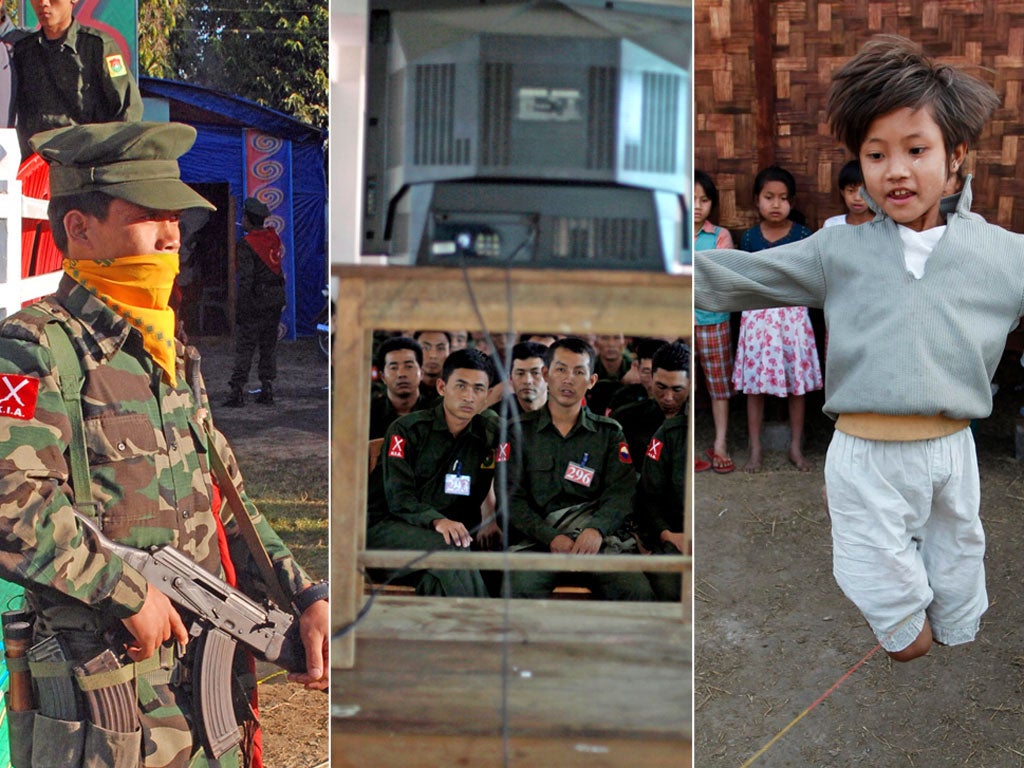Nowhere to run: rebels trapped in Burma's escalating ethnic war
Pinned against the Chinese border, the isolated Kachin people fear a bloody end to a long conflict

Ethnic Kachin fighters are locked in battle against Burmese forces after a government offensive on the border town of Laiza – where the Kachin Independence Organisation (KIO) is based – sparked fears that authorities are planning a final push to oust the rebels.
Fighting has been escalating since mid-April, when several rounds of peace talks – forming part of the government's much-heralded moves toward reform – reached no tangible outcome.
The leadership of the Kachin Independence Army (KIA) – Christians who have fought, on and off, for self-determination since 1961 – are now sandwiched between Burmese artillery and the Chinese border, which runs directly through the centre of Laiza.
On Sunday, government troops fought their way through Nam Sam valley, a flat landscape pockmarked by goldmines. Rebel soldiers, wearing camouflage fatigues with the distinctive red flash of the KIA badge, dug themselves in to machine-gun posts on top of piles of scree. Workers caught in the crossfire lay behind their trailers, sheltering from 81mm mortars, machine-gun fire and sniper bullets.
This is the first time that Laiza has been within range of Burmese artillery, with troops digging in on hilltops less than six miles from the town, and launching three separate attacks from the north, south and west in recent weeks. Last week, shells fired by Burmese troops landed less than 1,000 yards upstream from Laiza. In early May, 31 people were killed in skirmishes to the south of the town, according to the government.
As women in rainbow-hued tribal skirts spilled out of a Christian Mass at Laiza's Baptist church, pairs of guerrilla fighters armed with AK-47s and carrying drips in their hands for casualties sped past them on mopeds, rushing up the mountainside towards the fighting outside town.
Assistant commander Brang Mai rode a moped to the front line with a hand radio to deliver orders to 30 soldiers who were attacking a Burmese position. A slight farmer who joined the army two years ago, he now leads 400 men on Laiza's western front line. Gesturing to the hillside above, he points out a glinting corrugated iron roof marking a Burmese artillery post which has been pounding the empty village of Nam Sam. "You are very brave," said a voice on his radio. "Nobody has reached this far yet."
"They don't just want to occupy Laiza," Brang Mai said of the government forces. "They think that taking control of our headquarters will allow them to gain control of all KIA territory."
The urgency in the fighting is fuelled by the weather, he explains. The KIA must retake territory and put Laiza out of artillery range before the monsoon begins to soak the land, bogging down fighting and making the town vulnerable to attack throughout the wet season.
"The Burmese government have never given the KIA what they asked for," he said. "Before we signed a peace treaty with them, we had a terrible experience. They took our land and killed our people. Now they offer us peace. We can't trust them."
Laiza is home to the bulk of internally displaced people made homeless by the 10-month-long Kachin offensive, who are believed to number more than 75,000. The KIA estimates that about 40,000 now stay in Laiza itself.
Local groups say the fall of Laiza would almost certainly lead to a large- scale refugee crisis. The UN and its related agencies have visited once since the conflict began last year. Most of the refugee relief effort in Laiza is co-ordinated by the KIO and local aid groups.
Each Monday, in full view of the town's bustling marketplace, Chinese troops across the bridge hold drill sessions behind shields and rifles, apparently in preparation for a sudden rush of people fleeing a Burmese attack. "We have nowhere to flee," said a 23-year-old fisherman. "That is why we must defend ourselves to the last man."
Subscribe to Independent Premium to bookmark this article
Want to bookmark your favourite articles and stories to read or reference later? Start your Independent Premium subscription today.

Join our commenting forum
Join thought-provoking conversations, follow other Independent readers and see their replies